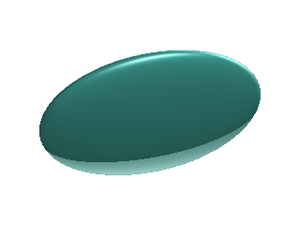Hard ellipsoid model: Difference between revisions
Carl McBride (talk | contribs) m (→Phase diagram: Added a new reference.) |
Carl McBride (talk | contribs) m (→References: Added a recent publication) |
||
| Line 77: | Line 77: | ||
*[http://dx.doi.org/10.1080/02678299008047365 Michael P. Allen "Computer simulation of a biaxial liquid crystal", Liquid Crystals '''8''' pp. 499-511 (1990)] | *[http://dx.doi.org/10.1080/02678299008047365 Michael P. Allen "Computer simulation of a biaxial liquid crystal", Liquid Crystals '''8''' pp. 499-511 (1990)] | ||
*[http://dx.doi.org/10.1016/j.fluid.2007.03.026 Carl McBride and Enrique Lomba "Hard biaxial ellipsoids revisited: Numerical results", Fluid Phase Equilibria '''255''' pp. 37-45 (2007)] | *[http://dx.doi.org/10.1016/j.fluid.2007.03.026 Carl McBride and Enrique Lomba "Hard biaxial ellipsoids revisited: Numerical results", Fluid Phase Equilibria '''255''' pp. 37-45 (2007)] | ||
*[http://dx.doi.org/10.1063/1.4812361 Wen-Sheng Xu , Yan-Wei Li , Zhao-Yan Sun and Li-Jia An "Hard ellipses: Equation of state, structure, and self-diffusion", Journal of Chemical Physics '''139''' 024501 (2013)] | |||
[[Category: Models]] | [[Category: Models]] | ||
Revision as of 18:39, 5 November 2013


Hard ellipsoids represent a natural choice for an anisotropic model. Ellipsoids can be produced from an affine transformation of the hard sphere model. However, in difference to the hard sphere model, which has fluid and solid phases, the hard ellipsoid model is also able to produce a nematic phase.
Interaction Potential
The general ellipsoid, also called a triaxial ellipsoid, is a quadratic surface which is given in Cartesian coordinates by
where , and define the lengths of the axis.
Overlap algorithm
The most widely used overlap algorithm is that of Perram and Wertheim [1].
Geometric properties
The mean radius of curvature is given by [2] [3]
and the surface area is given by
where is an elliptic integral of the first kind and is an elliptic integral of the second kind, with the amplitude being
and the moduli
and
where the anisotropy parameters, and , are
and
The volume of the ellipsoid is given by the well known
Mathematica notebook file for calculating the surface area and mean radius of curvature of an ellipsoid
Maximum packing fraction
Using event-driven molecular dynamics, it has been found that the maximally random jammed (MRJ) packing fraction for hard ellipsoids is for models whose maximal aspect ratio is greater than [4] [5]
Equation of state
- Main article: Hard ellipsoid equation of state
Virial coefficients
- Main article: Hard ellipsoids: virial coefficients
Phase diagram
One of the first phase diagrams of the hard ellipsoid model was that of Frenkel and Mulder (Figure 6 in [6]). Camp and Allen later studied biaxial ellipsoids [7]. It has recently been shown [8] [9] that the SM2 structure is more stable than the face centered cubic structure for aspect ratios and densities .
Hard ellipse model
- Main article: Hard ellipse model (2-dimensional ellipsoids)
References
- ↑ John W. Perram and M. S. Wertheim "Statistical mechanics of hard ellipsoids. I. Overlap algorithm and the contact function", Journal of Computational Physics 58 pp. 409-416 (1985)
- ↑ G. S. Singh and B. Kumar "Geometry of hard ellipsoidal fluids and their virial coefficients", Journal of Chemical Physics 105 pp. 2429-2435 (1996)
- ↑ G. S. Singh and B. Kumar "Molecular Fluids and Liquid Crystals in Convex-Body Coordinate Systems", Annals of Physics 294 pp. 24-47 (2001)
- ↑ Aleksandar Donev, Ibrahim Cisse, David Sachs, Evan A. Variano, Frank H. Stillinger, Robert Connelly, Salvatore Torquato, and P. M. Chaikin "Improving the Density of Jammed Disordered Packings Using Ellipsoids", Science 303 pp. 990-993 (2004)
- ↑ Aleksandar Donev, Frank H. Stillinger, P. M. Chaikin and Salvatore Torquato "Unusually Dense Crystal Packings of Ellipsoids", Physical Review Letters 92 255506 (2004)
- ↑ D. Frenkel and B. M. Mulder "The hard ellipsoid-of-revolution fluid I. Monte Carlo simulations", Molecular Physics 55 pp. 1171-1192 (1985)
- ↑ Philip J. Camp and Michael P. Allen "Phase diagram of the hard biaxial ellipsoid fluid", Journal of Chemical Physics 106 pp. 6681- (1997)
- ↑ M. Radu, P. Pfleiderer, T. Schilling "Solid-solid phase transition in hard ellipsoids", arXiv:0908.1043v1 7 Aug (2009)
- ↑ M. Radu, P. Pfleiderer, and T. Schilling "Solid-solid phase transition in hard ellipsoids", Journal of Chemical Physics 131 164513 (2009)
Related reading
- Michael P. Allen "Computer simulation of a biaxial liquid crystal", Liquid Crystals 8 pp. 499-511 (1990)
- Carl McBride and Enrique Lomba "Hard biaxial ellipsoids revisited: Numerical results", Fluid Phase Equilibria 255 pp. 37-45 (2007)
- Wen-Sheng Xu , Yan-Wei Li , Zhao-Yan Sun and Li-Jia An "Hard ellipses: Equation of state, structure, and self-diffusion", Journal of Chemical Physics 139 024501 (2013)




![{\displaystyle R={\frac {a}{2}}\left[{\sqrt {\frac {1+\epsilon _{b}}{1+\epsilon _{c}}}}+{\sqrt {\epsilon }}_{c}\left\{{\frac {1}{\epsilon _{c}}}F(\varphi ,k_{1})+E(\varphi ,k_{1})\right\}\right],}](https://wikimedia.org/api/rest_v1/media/math/render/svg/4e881e50476a138c1b82d0eff3fa835b1212160d)
![{\displaystyle S=2\pi a^{2}\left[1+{\sqrt {\epsilon _{c}(1+\epsilon _{b})}}\left\{{\frac {1}{\epsilon _{c}}}F(\varphi ,k_{2})+E(\varphi ,k_{2})\right\}\right],}](https://wikimedia.org/api/rest_v1/media/math/render/svg/0a0370210651aa0d817cf6bd9f11fc9898f4a23b)













